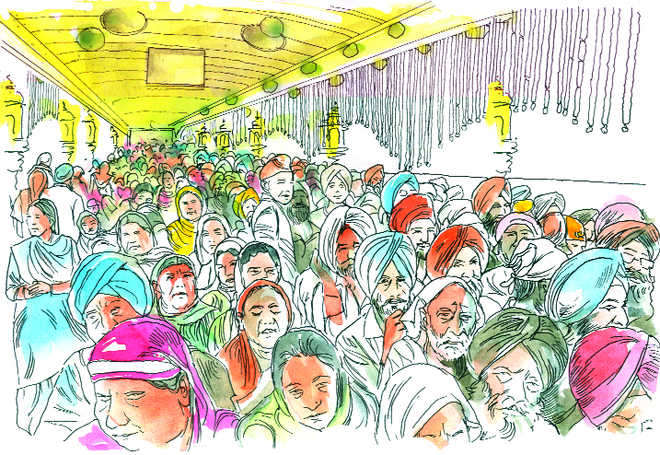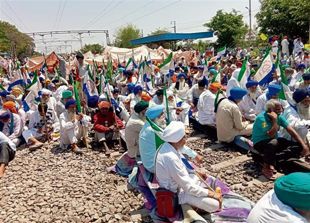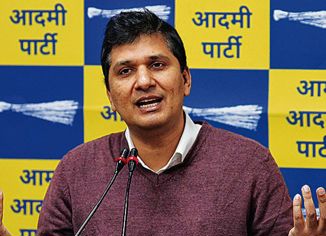
Illustration: Sandeep Joshi
Harish Khare
There is that nano-second, almost an ephemeral moment, when one gets the first sight of Harmander Saheb. And that first sighting stirs in a feeling of spiritual tranquility, despite the vastness of the view, the multitudes of devotees, the sarovar and its suggestion of enormity, and the golden glint. It is a magical moment that transports a pilgrim to a different, a nobler, an elevating universe.
Last weekend, I was in Amritsar at the invitation of Khalsa College; I had readily accepted the invitation because it meant, also, a chance to make the pilgrimage to the Golden Temple.
We had our audience with SGPC officials; got a briefing about the very many splendid community projects the committee undertakes; gratefully received a siropa, a copy of the History of The Sikhs and Their Religion, and a very fine replica of Harmandar Saheb. I felt honoured.
Then, the pilgrimage to the holy shrine. The parikarma. A spot was found for me in the crowded sanctum santorum. For half an hour, I soaked in the mellifluous shabad kirtan rendered by the raagis, as I meditated in humility and reverence. Again, that sense of spiritual tranquility overwhelmed me.
I felt like lingering on, but I did not feel I had the right to overstay, depriving the other devotees of their chance. Despite the hustle-bustle all round, there was that air of blessedness. I felt sanctified.
When I came out, the scene had undergone a kind of transformation; new LED lights, gentle, soothing, tasteful were giving the word dusk a new definition. As the dusky darkness of the evening came knocking, the soft lights enveloped the whole place in a gentle embrace, adding a new layer of aesthetic subtlety to the entire experience.
As is customary, the visitor is also shown the two poles (Nishan Sahebs), one shorter than the other, representing the miri-piri concept, symbolising the deference that the king must make to the priest. Though I was left wondering whether the SGPC hierarchy is able to operationalise this concept in the current context, given the Badals’ political overlordship.
There were vast crowds; but there was orderliness. Even the schoolchildren, smartly turned out in the Khalsa blue colour uniforms, were well behaved. There was no sense of angry impatience or the helter-skelteredness that one experiences at some other religious places.
********
What took me to Amritsar was an invitation from the historic Khalsa College to interact with its students in the Department of Journalism. The invitation was promptly accepted. Khalsa College is housed in what genuinely qualifies to be an iconic building. It has already been declared a heritage building. Blessed are those who get to visit, study, and teach in this wonderful surrounding. The grandeur and the majesty of the place make a lasting impression.
Khalsa College came up at a time when the old Punjab must have been undergoing great cultural and intellectual renaissance. It was around the time that visionary public figures were setting up different kinds of institutions (The Tribune 1881, Khalsa College, 1892, Dera Beas 1890s).
I am quite sure it was meant as a seat of secular learning and intellectual experimentation. Over the years, it has come to be seen as a nucleus of the “Khalsa culture” (as the opening line of the official college history proclaims.) The college gets its mojo from the principal of the day, and it has had some very distinguished educationists as its principals.
The current Principal, Dr Mahal Singh, is a very gracious man. Gentle and soft-spoken, he is trying to keep up with the changing times. He took great pride in showing me around the Department of Sikh History and Research. The pride was well placed. Set up in 1930, it is now regarded an essential place for any kind of research on Sikh history, I am told.
What is impressive is that this iconic building is being looked after well. I was informed that a few years ago, the then Chief Minister, Parkash Singh Badal, had made a very generous gift to the college, and the funds are being put to good use to undertake the much-needed renovations.
********
Having spent my childhood in the galis and bazaars of Old Delhi, I felt perfectly at home in the narrow lanes of Amritsar.
In fact, the hustle and bustle felt very familiar and very natural. It was pleasant to note that the streets were clean, and the drains were covered. There were not many signs of decay.
The city seemed at peace with itself and its limited economy, sustaining itself mostly on the pilgrimage tourism.
A visit to Amritsar is also incomplete without a taste of its food joints. Amritsar takes its food seriously. Much against the gentle warnings of my hosts to avoid the bazaar food, I did make the pilgrimage to Chowk Passian to taste the food at the legendary Kesar Da Dhaba. And food at the dhaba lived up to its reputation. The chef was at hand to urge you to eat this, that, and then that. The lassi, the parathas, chhole, kaali daal, baingan da bharta. Food to die for.
An ancient city, findings its anchor around a great holy site, is also trying to change. The new plaza is pleasing; things are less chaotic, as the movement of vehicular traffic has been severely curbed around the Golden Temple complex. There is no thinning of the pilgrims from all over the world. Momos, Domino’s pizzas, McDonald’s, Café Coffee Day, all trying to make a concession to the new taste of the new NRI tourist-pilgrim.
The city was being “transformed” and “beautified” by the old Badal regime before it was booted out. It was deemed as the pet project of the former Deputy Chief Minister. I was told that the new government has simply put a full-stop to whatever projects were in the pipeline. This is creating its own difficulties and eyesores. Whatever satisfaction it must have given to the new rulers, the citizens are being put to needless inconveniences. Someone should be telling the new bosses that vindictiveness neither makes good politics nor produces good policy choices.
********
The Sector 18 Market in Chandigarh is touted as the place to buy anything ‘electrical.’ A visit to this market on the eve of Diwali was educative. The place was teeming with shoppers wanting to buy electric decorative stuff. The traffic police were at hand to insist on some kind of orderly parking of cars.
There was an overabundance of Chinese products, all very reasonably priced — but all packed in ‘nationalistic’ card-boxes. The one I bought was emblazoned: PAARTH — Love In a Swachh Bharat. It had a drawing of the glittering Shanghai riverfront. The shopkeepers did not shy from telling you that these were Chinese goods and the buyers had no qualms in purchasing the Chinese stuff — notwithstanding the contrived and insincere campaign by the self-styled nationalist forces to boycott Chinese goods this Diwali (because of the Doklam standoff).
To ask the average citizen to not buy Chinese crackers or electric decorative stuff is the height of organised hypocrisy. Vast swathes of Indian economy thrive on imports from China. One very saffronnish-robed anchor even implored Amitabh Bachchan, invoking his sense of patriotism, to not advertise Chinese products.
The takeaway from all this: our nationalism is practical. Our electronic news channels can keep on mega-phoning the ruling party’s nationalism hype, but the average Indian remains self-assuredly detached. Perhaps, our citizens are beginning to understand the politicians’ game of politicising even the sacredness of nationalist sentiments.
I raise my cup of coffee to this detachment. Join me.



























